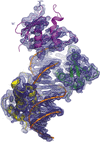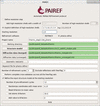issue contents
July 2021 issue

research communications
Open  access
access
 access
accessThe structure of a designed ankyrin-repeat protein that selectively binds to domain 4 of HER3, an important driver of malignant growth in many tumors, has been determined. The structure helps to explain the selectivity against other members of the HER family, and binding to this epitope will interfere with its interactions in the tethered (inactive) and extended (active) conformations.
Open  access
access
 access
accessSolution of the structure of the DNA-binding domain of interferon regulatory factor 4 bound to its interferon-stimulated response element by native intrinsic phosphorus and sulfur single-wavelength anomalous dispersion methods (native SAD) is described.
PDB reference: DNA-binding domain of interferon regulatory factor 4, 7o56
Open  access
access
 access
accessThe influenza virus nucleoprotein binds to the viral RNA genome and is essential for virus replication. Here, the structure of the nucleoprotein from an H3N2 virus is presented at 2.2 Å resolution.
PDB reference: H3N2 influenza virus nucleoprotein, 7nt8
Open  access
access
 access
accessIn a domain-swapped, gel-like crystalline form of Escherichia coli tryptophan repressor, the physiological ligand L-tryptophan binds equivalently as in the native dimeric repressor, even though the binding-site residues originate from three distinct polypeptide chains instead of two, and large solvent channels accommodate a disordered N-terminal extension. Proteins that cannot otherwise be crystallized might be oriented in the channels for diffraction analysis by exploiting these features.
methods communications
Support for the refinement engine phenix.refine has been implemented into PAIREF, a tool providing automatic paired refinement.


 journal menu
journal menu

















![[publBio]](/logos/publbio.gif)





